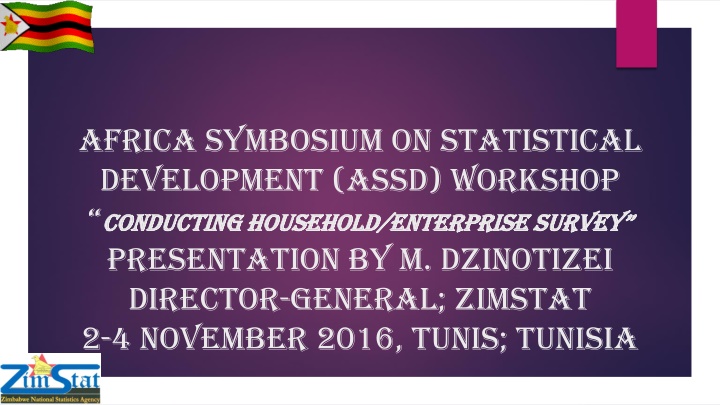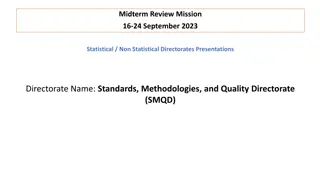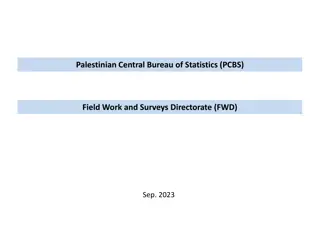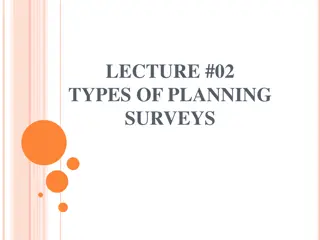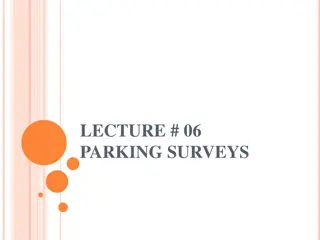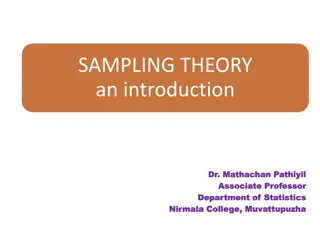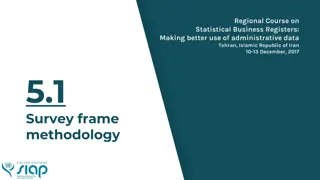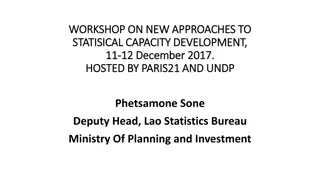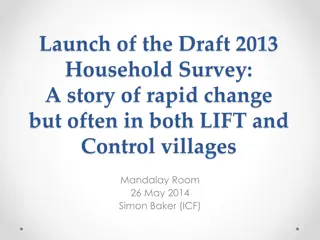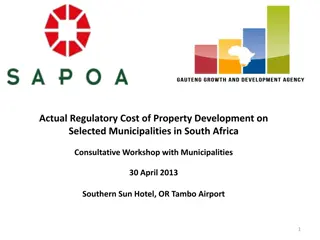Africa Statistical Development Workshop on Household & Enterprise Surveys
Carrying out surveys in Zimbabwe for data collection on social and demographic statistics, encompassing household and enterprise surveys, challenges, opportunities, and implementation processes. ZIMSTAT plays a critical role in maintaining representative samples for the surveys.
Download Presentation

Please find below an Image/Link to download the presentation.
The content on the website is provided AS IS for your information and personal use only. It may not be sold, licensed, or shared on other websites without obtaining consent from the author.If you encounter any issues during the download, it is possible that the publisher has removed the file from their server.
You are allowed to download the files provided on this website for personal or commercial use, subject to the condition that they are used lawfully. All files are the property of their respective owners.
The content on the website is provided AS IS for your information and personal use only. It may not be sold, licensed, or shared on other websites without obtaining consent from the author.
E N D
Presentation Transcript
Africa Symbosium on Statistical Development (ASSD) Workshop ConduCting HouseHold/enterprise survey ConduCting HouseHold/enterprise survey Presentation by M. Dzinotizei Director-General; ZIMSTAT 2-4 November 2016, Tunis; Tunisia
Presentation Outline What is a household/enterprise survey Introduction to Zimbabwe s household/enterprise survey Household Surveys in Zimbabwe; implementation process Enterprise Surveys in Zimbabwe; implementation process Challenges, opportunities and Gap Analysis Conclusion
Household/Enterprise Survey An Enterprise Survey is a firm-level survey of a representative sample of an economy's private sector. The surveys cover a broad range of business environment topics. A household survey is a study for the collection of detailed and varied socio-demographic data pertaining to conditions under which people live, their well-being, activities in which they engage, demographic characteristics and cultural factors which influence behaviour, as well as social and economic change.
Introduction ZIMSTAT, as the producer of official statistics, carries out regular household and establishment based on behalf of the government and development partners. In order for these surveys to be representative of the universe population, ZIMSTAT maintains and updates two master frames that is the Zimbabwe Master Sample 2012 (ZMS12) and the Central Business Register (CBR). Household surveys draw samples from ZMS12 while economic surveys draw samples from the CBR. The maintenance and updating of both the CBR master frame and the Zimbabwe Master Sample is imperative for ZIMSTAT in the execution of its duties.
Household Surveys Zimbabwe has in place household survey programmes that include both periodic and adhoc surveys. The household survey programme is part of an integrated statistical data collection system of Zimbabwe. The Zimbabwe National Household Survey Capability Programme (NHSCP) was a major effort to help the county establish the statistical and survey capabilities to obtain requisite socio-economic and demographic information from the household sector.
Household Surveys Carried in Zimbabwe There are different types of household surveys ZIMSTAT conduct to collect data on social and demographic statistics. The selection of the appropriate type of survey is dependent on a number of factors including subject matter requirements, resources and logistical considerations. Some of the household surveys done in Zimbabwe are: Zimbabwe Population Census (2012) Intercensol Demographic Survey (2008) Zimbabwe Demographic and Health Survey (2015) Multiple Indicator Cluster Survey (2014) Labourforce Survey (2014) Agriculture and Livestock survey (2015) Poverty Income and Expenditure Survey (2011/12)
Household Surveys Cont.. For a survey to yield desired results, there is need to pay particular attention to the preparations that precede the field work. In this regard all surveys carried out by ZIMSTAT have careful and judicious preparations for them to be successful. The amount of planning will vary depending on the type of survey, materials and information required.
Data Collection Method The face to face interview method is commonly used by ZIMSTAT in collecting data through large scale sample surveys. The method entails interviewers going to selected respondents collecting information by asking questions. The main advantage of this method is that the interviewers can persuade (through motivation) respondents to answer questions and can explain the objectives of the survey. There is also greater potential for collecting statistical information on conceptually difficult items which are likely to yield ambiguous answers in other types of interviews. ZIMSTAT uses both paper questionnaires and Personal Digital Assistants (PDAs) during data collection depending on the type of survey. There is determined effort to move towards Computer Aided Personal Interviews in the next 3-4 years
Maintenance and updating of ZMS12 In terms of its effect on population coverage proper maintenance of a master sample frame is a key element in its development and in planning for its use. The ZMS12 is used for the decade between censuses, during which time far-reaching shifts in population movement are likely to occur. It is necessary to up-date the frame periodically to reflect population changes so that it will continue to be representative. The changes are mainly: Changes in administrative divisions that alter the administrative belonging of the Primary Sampling Unit. Changes in the land use sector characteristic of the frame unit; Changes in the measure of size of the PSU (number of households in the PSU).
Maintenance and Updating of ZMS12.. Changes in administrative divisions affecting a frame unit should be reflected in the Master Sample Frame. Changes that affect the land use sector characteristic of frame units will take place but the classification of the units will stay unchanged between censuses. There is therefore no case for updating the sector classification. Changes in the measure of size do not necessarily have to be reflected in the master sample frame Updates of administrative changes and reclassifications should be done regularly for units in the master sampling frame If and only if there are changes in administrative boundaries.
UPDATING OF MEASURES OF SIZE If there are fast growing urban or semi-urban areas due to influx of people from rural areas the measures of size may have to be adjusted. It should be possible to pinpoint these areas through consultations with the planning department at district or ward level. ZIMSTAT; after 3-4 years makes an effort to identify fast growing areas and then adjust the measures of size for the frame units in these areas. The adjustment can be based on: crude information on the current number of households. A quick count of households in the area (frame unit). Asking local planners to give a crude estimate of the number of households. Ongoing household surveys can be used to update the master sample frame through the household listing operations for household based surveys. The Inter-Censol Demographic Survey which comes in 5 years after the National census will be used to update ZMS12
Confidentiality Confidentiality of the survey respondents and the sensitive information they provide is necessary to ensure the greatest degree of survey participation, integrity and confidence in the quality of the data. ZIMSTAT conducts surveys under the provisions of the Census and Statistics Act Chapter [10:29] of 2007 Some Surveys are carried out in cooperation with business organizations, government agencies and development partners but confidentiality is never compromised.
The Enterprise Survey-Who is surveyed: The Enterprise Survey is answered by business owners and top managers. All economic activities as classified by ISIC Revision 4 are surveyed depending on the survey. Formal (registered) companies with 10 or more employees are targeted for interview in the Quarterly Employment Inquiry. Companies with less than 10 employees are also covered in the employment inquiry but once a year
Enterprise Survey-Structure of the surveys: ZIMSTAT carries out a number of economic surveys and these include, Central Business Register Inquiry, Quarterly Employment Inquiry, Index of Industrial Production, Census of Industrial Production and Survey of Services among others Although many questions overlap, some are only applicable to one type of business. For example, retail firms are not asked about production and nonproduction workers. The questionnaires include questions on company characteristics, annual sales, costs of inputs/labor, workforce composition, licensing, capital, capacity utilization, taxation, The mode of data collection is face-to-face interviews.
Sampling-Use of the CBR The sampling methodology for Enterprise Surveys is stratified random sampling. In a stratified random sample, all population units are grouped within homogeneous groups and simple random samples are selected within each group. This method allows computing estimates for each of the strata with a specified level of precision while population estimates can also be estimated by properly weighting individual observations. The strata for Enterprise Surveys are firm size, business sector, and geographic area within Zimbabwe. The survey sample frame is derived from the universe of eligible firms obtained from the Central Business register created in 2014 with the help of USAID-SERA programme. All the economic surveys are carried out with survey frames from the CBR.
Importance of the CBR An up-to-date frame is required for all economic surveys. Independently created survey frames may have unintentional duplication or may lead to omission of establishments. A CBR enables practical application of a standard framework of units and their classifications. A CBR is required to derive basic demographical characteristics of establishments that is their births, deaths and mergers and takeovers.
Enterprise Survey-Methodology ZIMSTAT carries out Enterprise Surveys based on clearly defined objectives, sound collection methodology, well-established legal basis; properly designed questionnaires, well-defined data structures and well defined industrial classifications. Surveys of enterprises collect information in aggregate form and such surveys may be full coverage (CIP; IIP) or conducted on a sample basis (SoS, CPS). Surveys of enterprises are conducted to collect information from enterprises engaged in specific activities or may be applied to a wide range of enterprises to collect information on all of their services transactions These surveys require the use of an up-to-date CBR and good survey techniques.
Challenges in Carrying out Enterprise Surveys Questions on household income and wealth are sensitive and respondents may find them particularly intrusive. Convincing potential respondents to participate in the survey and also building up trust in order to collect truthful responses is quite a challenge but at the same time essential for the success of the survey. Enterprise surveys suffer from non-response. This is usually reduced by visiting the establishment several times There is a challenge of collecting accurate data especially from establishments with an informal setting. These establishments by nature of their operations do not have books of accounts. In some instances, field staff are mistaken as tax authorities, This affect the response rate. The red-tape bureaucracy. The interviewers on a number of occasions have to go through so many supervisory levels to meet the owner of the establishment. The owners are usually responsible for deciding on whom to complete the questionnaire being administered.
Strengths of the Data Collection System in Zimbabwe Recognition of ZIMSTAT as the primary source of official statistics Experienced, competent and dedicated staff Established statistical infrastructure Existence of the Compendium of Statistical Concepts and Definitions Compliance with international standards (and use of international statistical software) Good relationships with users, other producers and service providers Existence of Sector Statistical Committees
Opportunities in the Data Collection System in Zimbabwe Increased government commitment to support statistical development Increased recognition of the importance of statistics and increased demand The statistics law that supports better coordination and organization of the National Statistics System Existing and potential funding from development partners
Conclusion ZIMSTAT carries out regular household and establishment based surveys. ZIMSTAT maintains and updates two master frames that is the Zimbabwe Master Sample 2012 (ZMS12) and the Central Business Register. The face to face interview method is commonly used by ZIMSTAT in collecting data using both paper questionnaires and Personal Digital Assistants (PDAs). Enterprise surveys are done and all economic activities classified by ISIC Revision 4. ZIMSTAT conducts surveys under the provisions of the Census and Statistics Act Chapter [10:29] of 2007 where the issie of privacy and confidentiality of data are of paramount importance
